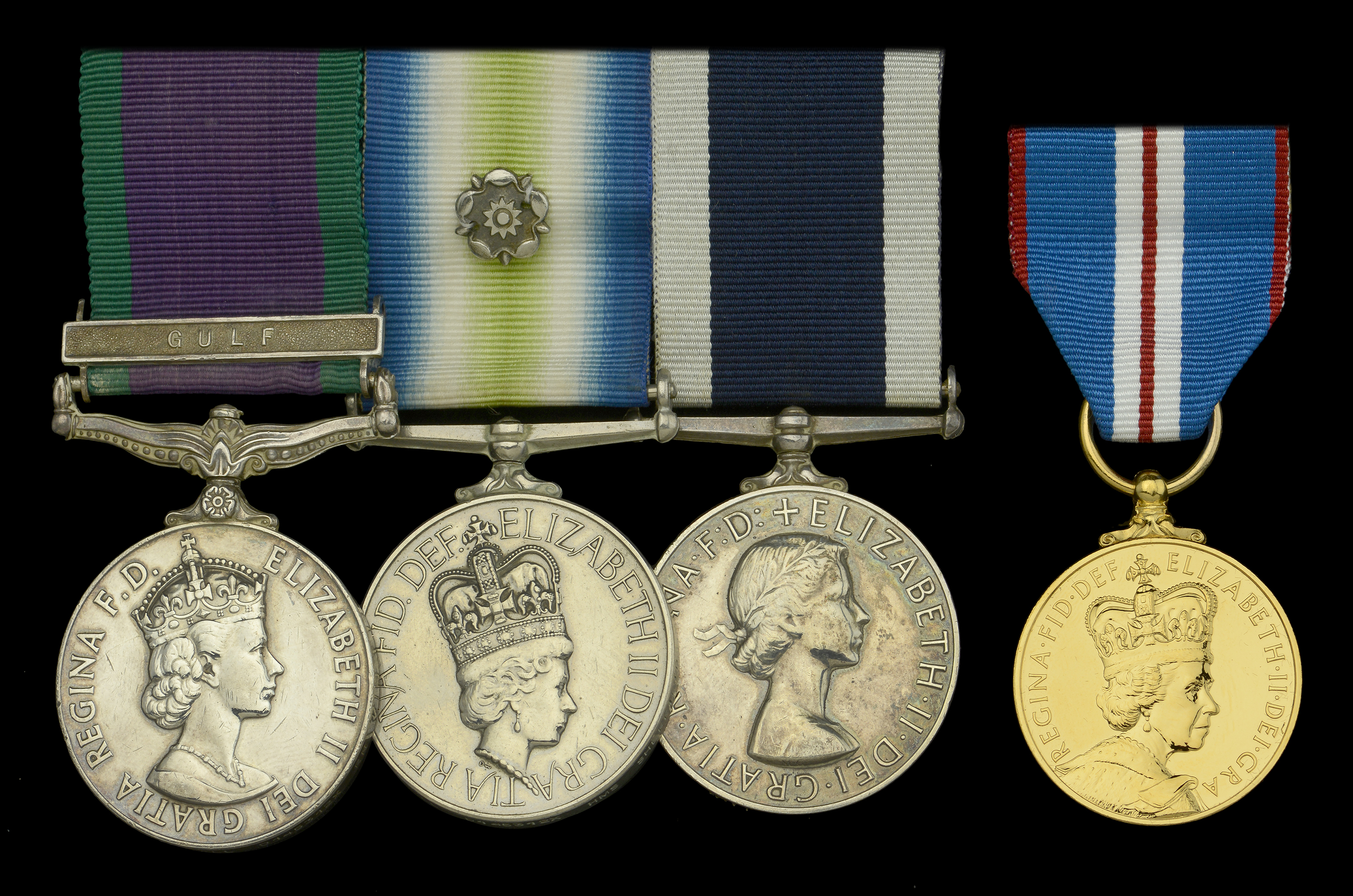The South Atlantic and Gulf operations group of four awarded to Lieutenant-Commander S. J. Ball, Royal Navy, who was aboard H.M.S. Sheffield when she was sunk by an Exocet Missile during the Falklands War, the first Royal Navy vessel sunk in action since the Second World War General Service 1962-2007, 1 clasp, Gulf (CCMEA(M) S J Ball D145312X RN); South Atlantic 1982, with rosette (MEA(M)1 S J Ball D145312X HMS Sheffield); Royal Navy L.S. & G.C., E.II.R., 2nd issue (ASLT S J Ball RN) mounted in incorrect order as worn, together with Jubilee 2002, unnamed, in card box of issue, first medal with contact marks, very fine and better (4) £2,000-£2,400 --- Importation Duty This lot is subject to importation duty of 5% on the hammer price unless exported outside the UK --- --- Provenance: Dix Noonan Webb, July 2011. Stephen James Ball was born in 1956 in Tripoli, Libya. He volunteered for service in the Royal Navy in January 1974 serving aboard a number of different vessels, including H.M.S. Sheffield from 3 March 1980, which ship he was still serving aboard when she was sunk by an Exocet missile during the Falklands War. A specialist engineer, he received his commission in February 1989, remaining with the service until his retirement as Lieutenant-Commander in September 2006. The sinking of H.M.S. Sheffield At approximately 10a.m. on 4 May 1982, HMS Sheffield was at defence watches, second degree readiness, as part of the British Task Force dispatched to the Falkland Islands. Sheffield had relieved her sister ship Coventry as the latter was having technical trouble with her radar. Sheffield and Coventry were chatting over the radio when communications suddenly ceased. Then an unidentified message was heard flatly stating "Sheffield is hit". The flagship, Hermes dispatched the escorts Arrow and Yarmouth to investigate, and a helicopter was launched. Confusion reigned until Sheffield's Lynx helicopter unexpectedly landed aboard Hermes carrying the Air Operations Officer and Operations Officer, confirming the disaster. Sheffield had picked up the incoming missiles on her ancient radar system and the Operations Officer informed the Missile Director, who queried the contacts with the fire control system. The launch aircraft had not been detected as the British had expected, and it was not until smoke was sighted that the target was confirmed as sea skimming missiles. Five seconds later, an Exocet impacted Sheffield amidships, approximately 8 feet above the waterline on Deck 2, tearing a gash in the hull, whilst the other one splashed into the sea half a mile off her port beam. The Exocets were fired from two Super Étendards launched from Río Grande, Tierra del Fuego, Naval Air Base, piloted by Lieutenant Armando Mayora and Captain Augusto Bedacarratz, who commanded the mission. The MOD report into the sinking of the Sheffield concluded that; "Evidence indicates that the Warhead did not detonate". Some of the crew and members of the Task Force believe however that the missile's 165 kilogram warhead did in fact detonate upon impact. Regardless, the impact of the missile and the burning rocket motor set Sheffield ablaze. Accounts suggest that the initial impact of the missile immediately crippled the ship's onboard electricity generating systems and fractured the water main, preventing the anti-fire mechanisms from operating effectively, and thereby dooming the ship to be consumed by the raging fire. After the ship was struck, her crew, waiting to be rescued, sang "Always Look on the Bright Side of Life" from Monty Python's Life of Brian. The burnt-out hulk was taken in tow by the Rothesay class frigate HMS Yarmouth but sank at 53°04'S, 56°56' W on 10 May 1982; high seas led to slow flooding through the hole in the ship’s side which eventually took her to the bottom. This made her the first Royal Navy vessel sunk in action in almost forty years. Twenty of her crew (mainly on duty in the Galley area) died during the attack. The wreck is a war grave and designated as a protected place under the Protection of Military Remains Act 1986. Sold with original Certificate of Service, History Sheet for Marine Engineering Artificer, copy of recipient’s final appraisal prior to his retirement, Kit Record Book and three photographs including recipient.





